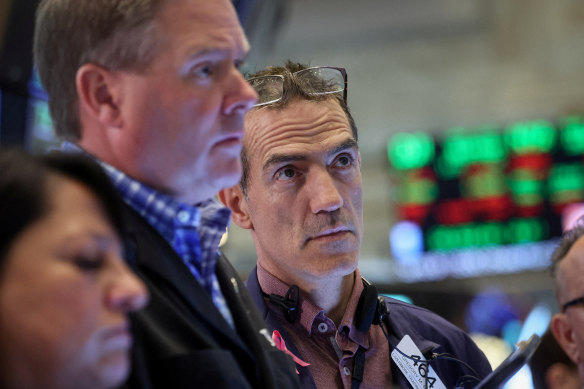- Updated
- Business
- Markets
- World markets
ASX closes in the green as miners post healthy gains
By Staff reporters
The Australian sharemarket has managed to close out the week in the green, with mining and energy stocks doing the heavy lifting and helping the ASX 200 recover from a couple of lacklustre sessions.
The S&P/ASX 200 finished the session 60.1 points higher, or 0.8 per cent, at 7921.3. The materials sector gained 1.4 per cent, with Mineral Resources the standout. Shares of billionaire Chris Ellison’s lithium miner closed 3.4 per cent stronger after it posted a 9 per cent increase in its FY 2024 production volumes.
Rio Tinto was the best of the iron ore heavyweights (up 2.8 per cent), while BHP (2.2 per cent) and Fortescue (1 per cent) also enjoyed a healthy session, as iron ore prices started to recover after dipping below $US99.90 a tonne.

It was a rollercoaster day of trading on Wall Street.Credit: Reuters
Gold miners were on the opposite end of the spectrum, with Newmont declining 2.3 per cent, Northern Star Resources dipping 3 per cent and Bellevue Gold diving 21.5 per cent after completing a $150 million equity capital raise.
The energy sector (up 0.8 per cent) was another strong performer, with Santos up 1.2 per cent and Woodside up 0.3 per cent. The local technology sector ended the session in positive territory (up 0.7 per cent), with cloud accounting giant Xero up 1.1 per cent and WiseTech global up 1.5 per cent.
Of the big banks, ANZ ended the day 0.5 per cent weaker, Westpac edged up 0.8 per cent, NAB pushed up 0.5 per cent and CBA picked up some steam to end in the green (up 0.4 per cent).
Consumer staples was the only sector in the red.
AMP Australia chief economist Shane Oliver said local shares had been dragged lower by the global falls but the ASX 200 was still above its March record high.
Along with weakness in the US market, Japanese shares took a hit from further talk of monetary tightening and Chinese shares were lower after a lack of decisive stimulus following the Third Plenum.
“The good news is that global interest rates are continuing to roll over as the focus for central bankers shifts from getting inflation down to avoiding recession,” Dr Oliver wrote in a note.
“The bad news is that shares may be entering another correction on the back of a growth scare.”
On Thursday, a swirling day of trading on Wall Street left the S&P 500 with a loss of 0.5 per cent following its slide from the day before, which was its worst since 2022 and led to a wipeout for financial markets around the world.
The Dow Jones rose 0.2 per cent, while the Nasdaq composite sank 0.9 per cent.
Weighing on Wall Street were continued losses for Nvidia and most of the handful of Big Tech stocks that have been primarily responsible for the S&P 500’s run to records this year. They had tumbled a day earlier after profit reports from Tesla and Alphabet underwhelmed and raised concerns that the market’s frenzy around artificial-intelligence technology had sent prices too high.
Whether the handful of stocks known as the “Magnificent Seven” are rising or falling makes a huge impact on Wall Street because they’ve grown so mammoth in market value. That gives their stock movements extra sway on the S&P 500 and other indexes.
But Thursday’s drops for six of the Magnificent Seven masked a market where the majority of US stocks rallied. A surprisingly strong report on the US economy raised hopes for profits at smaller stocks and other formerly unloved areas of the market.
It’s a flip of the leaderboard from earlier this year, when strength for Big Tech masked weakness for other stocks, which struggled with high interest rates meant to get inflation under control.
The economy’s growth accelerated to an estimated 2.8 per cent annual rate from April through June, double the rate from the prior quarter. A continuation would help drive more sales for companies. Perhaps just as importantly for Wall Street, the report wasn’t so hot that it fanned worries about upward pressure on inflation.
The next update on the Federal Reserve’s preferred measure of inflation could shake things up, but “it’s a struggle to find data points or indicators that hint at inflation still being a significant concern,” according to Yung-Yu Ma, chief investment officer at BMO Wealth Management.
Because inflation has largely resumed its slowdown, the widespread expectation is for the Federal Reserve to begin cutting its main interest rate from the highest level in more than two decades. Following Thursday’s report, traders still see a 100 per cent probability that the Fed will begin doing so in September, according to data from CME Group.
Cuts to rates would release pressure that’s built up on both the economy and financial markets, and investors are thinking it could offer a particularly big boost to smaller stocks and other downtrodden areas whose profits are more closely tied to the strength of the economy than Big Tech’s.
The Russell 2000 index of smaller stocks jumped 1.3 per cent, doing better than other market indexes. It’s up 8.6 per cent this month, versus a loss of 1.1 per cent for the big stocks in the S&P 500.
In the bond market, the yield on the 10-year Treasury slipped to 4.24 per cent from 4.28 per cent late Wednesday. It’s down significantly from its perch of 4.70 per cent reached in April, which gives a strong boost to stock prices.
With AAP and AP
The Market Recap newsletter is a wrap of the day’s trading. Get it each weekday afternoon.